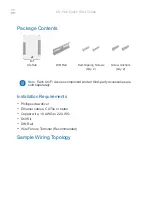5. The fourth screen shows the temperature and humidity measured by the Silicon Labs Si7021 Humidity and Temperature Sensor,
mounted on the top-right of the kit. Tapping the virtual button toggles between Celsius and Fahrenheit.
6. The fifth screen shows data coming from the capacitive sense slider. The EFM32GG11 Giant Gecko has an advanced SAR-based
capacitive touch peripheral with up to 64 inputs that provides the touch measurements. Use the virtual [
Swipe lock
] button to inter-
act more freely with the slider in this screen.
lock
unlock
slide
7. The sixth screen shows the ultra-low power LESENSE peripheral in action, as well as the True Random Number Generator
(TRNG) peripheral, both on the EFM32GG11 Giant Gecko. On this screen, LESENSE is monitoring the LC sensor on the bottom
right of the kit. When it senses closeness of metal, the TRNG is used to generate a new color for the LEDs. Move a piece of metal
up to the top of the LC Sense coil to try this out.
8. The seventh screen features the backup mode of the EFM32GG11 Giant Gecko. This mode leverages a 20 mF super-cap to keep
the RTC and some memory alive on the MCU in the event of power-loss. To try it out, power the kit from a CR2032 battery and
click the [
Charge On
] virtual button to enable charging of the super-cap. Then, wait until the display says [
BU ready
]. Note the time
displayed in the top-right corner of the screen. At this point, you can move the power-switch on the kit away from the [
BAT
] posi-
tion, effectively disconnecting the battery from the EFM32GG11 Giant Gecko. Wait for ~5 seconds, then turn the switch back to
[
BAT
]. This will return to the backup screen where the time value in the top-right corner of the screen continued counting while the
power was off.
QSG149: EFM32GG11-SLSTK3701A Quick-Start Guide
Getting Started
silabs.com
| Building a more connected world.
Rev. 0.1 | 5


















